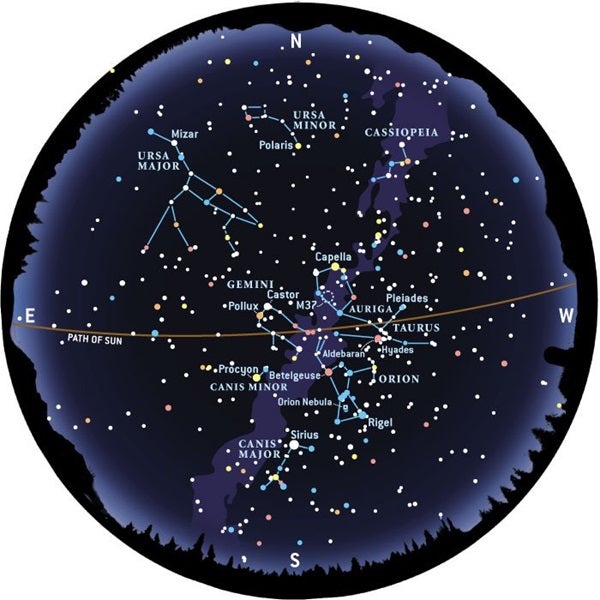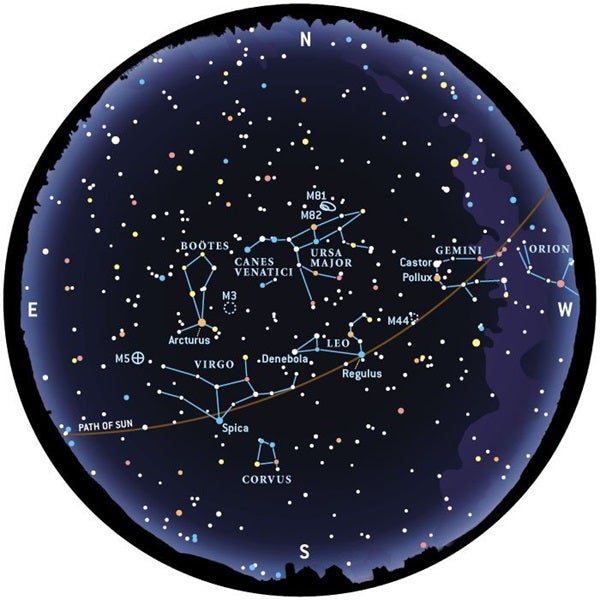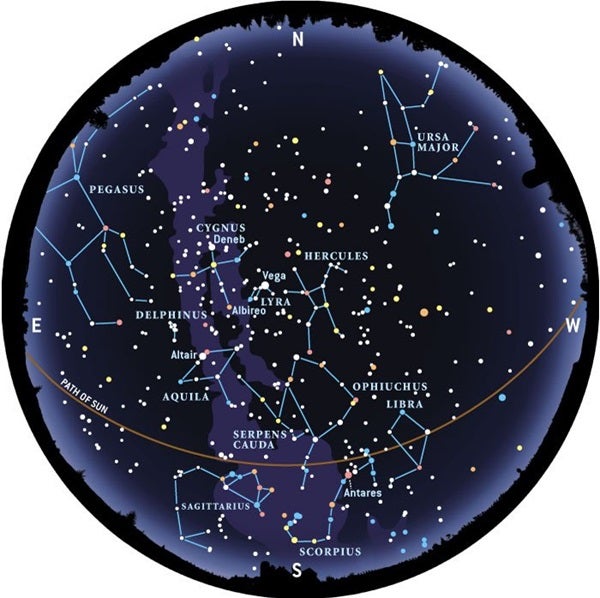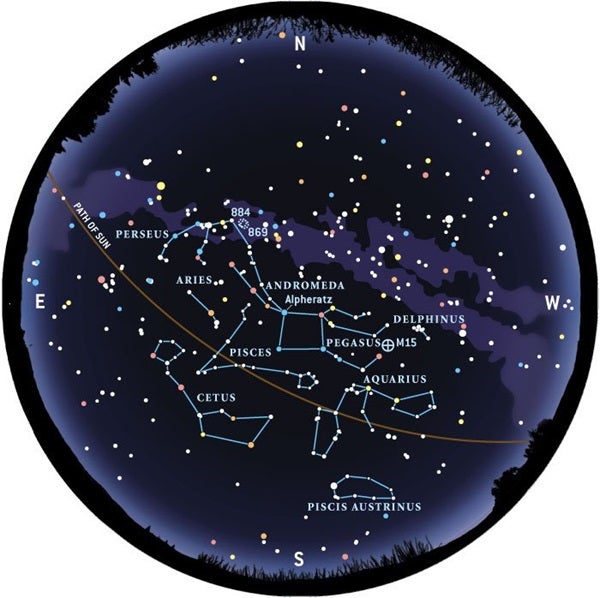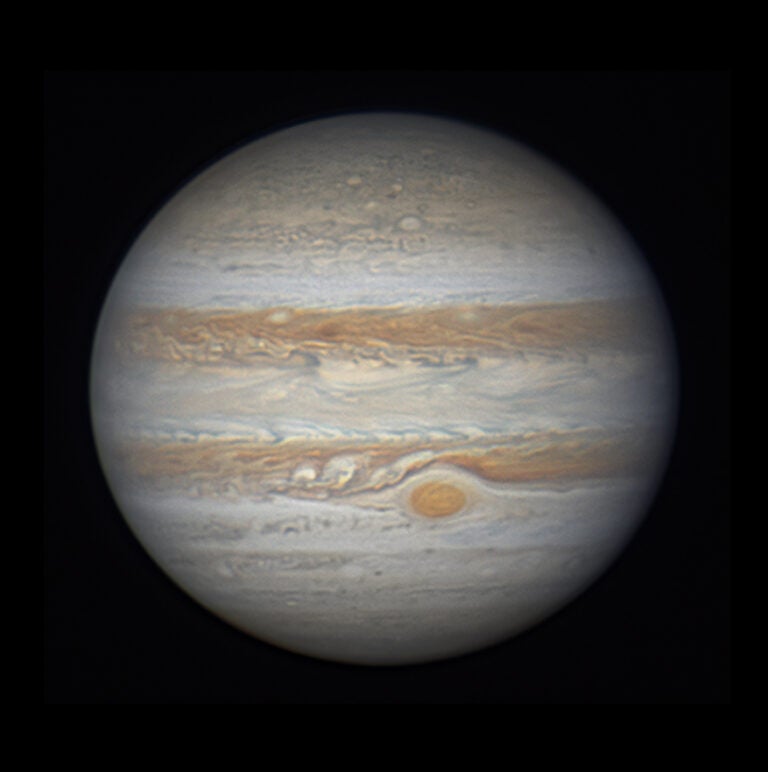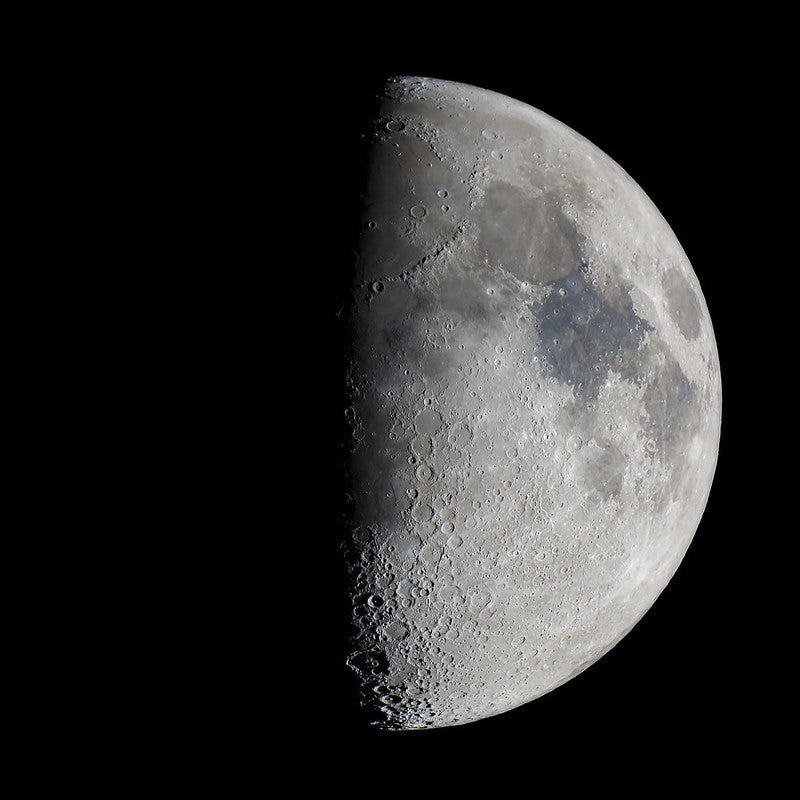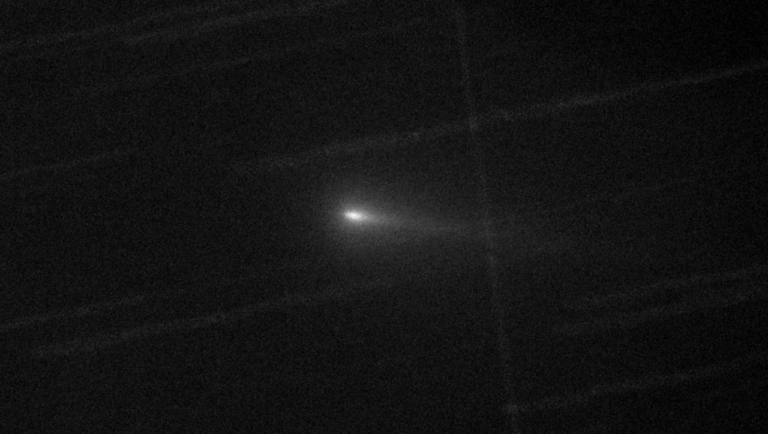Each map portrays the sky as seen from near 35° north latitude at the times shown below. Located on the edges of the map are the four directions: north, south, east, and west. To find stars above your horizon, hold the map overhead and orient it so a direction label matches the direction you’re facing. The stars above the map’s horizon now match what’s in the sky.
Winter finds the Big Dipper climbing the northeastern sky, with the three stars of its handle pointing toward the horizon and the four stars of its bowl standing highest. The entire sky rotates around a point near Polaris, a 2nd-magnitude star found by extending a line from the uppermost pair of stars in the bowl across the sky to the left of the Dipper. Polaris also performs two other valuable functions: The altitude of the star above the horizon equals your latitude north of the equator, and dropping a straight line from the star to the horizon points due north.
Turn around with your back to the Dipper and you’ll be facing the diamond-studded winter sky. The second great signpost in the sky, Orion the Hunter, is central to the brilliant scene. Three closely spaced, 2nd-magnitude stars form a straight line that represents the unmistakable belt of Orion. Extending the imaginary line joining these stars to the upper right leads to Taurus the Bull and its orangish 1st-magnitude star, Aldebaran. Reverse the direction of your gaze to the belt’s lower left and you cannot miss Sirius the Dog Star — brightest in all the heavens at magnitude -1.5.
Now move perpendicular to the belt from its westernmost star, Mintaka, and find the red supergiant star Betelgeuse at the upper left of Orion. Nearly a thousand times the Sun’s diameter, Betelgeuse marks one shoulder of Orion. Continuing this line brings you to a pair of bright stars, Castor and Pollux. Two lines of fainter stars extend from this pair back toward Orion — these represent Gemini the Twins. At the northeastern corner of this constellation lies the beautiful open star cluster M35. Head south of the belt instead and your gaze will fall on the blue supergiant star Rigel, Orion’s other luminary.
Above Orion, and nearly overhead on winter evenings, is brilliant Capella in Auriga the Charioteer. Extending a line through the shoulders of Orion to the east leads you to Procyon in Canis Minor the Little Dog. Once you have these principal stars mastered, using the chart to discover the fainter constellations will be a lot easier. Take your time, and enjoy the journey. Before leaving Orion, however, aim your binoculars at the line of stars below the belt. The fuzzy “star” in the middle is actually the glorious Orion Nebula (M42), a stellar nursery illuminated by bright, newly formed stars.
Winter constellation audio tours
The Big Dipper, our signpost in the sky, swings high overhead during the spring and lies near the center of the chart. This season of rejuvenation encourages us to move outdoors with the milder temperatures, and with the new season a new set of stars beckons us.
Follow the arc of stars outlining the handle of the Dipper away from the bowl and you will land on brilliant Arcturus. This orangish star dominates the spring sky in the kite-shaped constellation Boötes the Herdsman. Well to the west of Boötes lies Leo the Lion. You can find its brightest star, Regulus, by using the pointers of the Dipper in reverse. Regulus lies at the base of a group of stars shaped like a sickle or backward question mark, which represents the head of the lion.
Midway between Regulus and Pollux in Gemini, which is now sinking in the west, is the diminutive group Cancer the Crab. Centered in this group is a hazy patch of light that binoculars reveal as the Beehive star cluster (M44).
To the southeast of Leo lies the realm of the galaxies and the constellation Virgo the Maiden. Virgo’s brightest star, Spica, shines at magnitude 1.0.
During springtime, the Milky Way lies level with the horizon, and it’s easy to see that we are looking out of the plane of our galaxy. In the direction of Virgo, Leo, Coma Berenices, and Ursa Major lie thousands of galaxies whose light is unhindered by intervening dust in our own galaxy. However, all these galaxies are elusive to the untrained eye and require binoculars or a telescope to be seen.
Boötes lies on the eastern border of this galaxy haven. Midway between Arcturus and Vega, the bright “summer” star rising in the northeast, is a region where no star shines brighter than 2nd magnitude. A semicircle of stars represents Corona Borealis the Northern Crown, and adjacent to it is a large region that houses Hercules the Strongman, the fifth-biggest constellation in the sky. It’s here we can find the northern sky’s brightest globular star cluster, M13. A naked-eye object from a dark site, it looks spectacular when viewed through a telescope.
Returning to Ursa Major, check the second-to-last star in the Dipper’s handle. Most people will see it as double, while binoculars show this easily. The pair is called Mizar and Alcor, and they lie just 0.2° apart. A telescope reveals Mizar itself to be a double. Its companion star shines at magnitude 4.0 and lies 14 arcseconds away.
Spring constellation audio tours
The richness of the summer sky is exemplified by the splendor of the Milky Way. Stretching from the northern horizon in Perseus, through the cross-shaped constellation Cygnus overhead, and down to Sagittarius in the south, the Milky Way is packed with riches. These riches include star clusters, nebulae, double stars, and variable stars.
Let’s start with the Big Dipper, our perennial signpost, which now lies in the northwest with its handle still pointing toward Arcturus. High overhead, and the first star to appear after sunset, is Vega in Lyra the Harp. Vega forms one corner of the summer triangle, a conspicuous asterism of three stars. Near Vega lies the famous double-double, Epsilon Lyrae. Two 5th-magnitude stars lie a little more than 3 arcminutes apart and can be split when viewed through binoculars. Each of these two stars is also double, but you need a telescope to split them.
To the east of Vega lies the triangle’s second star: Deneb in Cygnus the Swan (some see a cross in this pattern). Deneb marks the tail of this graceful bird, the cross represents its outstretched wings, and the base of the cross denotes its head, which is marked by the incomparable double star Albireo. Albireo matches a 3rd-magnitude yellow star and a 5th-magnitude blue star and offers the finest color contrast anywhere in the sky. Deneb is a supergiant star that pumps out enough light to equal 60,000 Suns. Also notice that the Milky Way splits into two parts in Cygnus, a giant rift caused by interstellar dust blocking starlight from beyond.
Altair, the third star of the summer triangle and the one farthest south, is the second brightest of the three. Lying 17 light-years away, it’s the brightest star in the constellation Aquila the Eagle.
Frequently overlooked to the north of Deneb lies the constellation Cepheus the King. Shaped rather like a bishop’s hat, the southern corner of Cepheus is marked by a compact triangle of stars that includes Delta Cephei. This famous star is the prototype of the Cepheid variable stars used to determine the distances to some of the nearer galaxies. It varies regularly from magnitude 3.6 to 4.3 and back again with a 5.37-day period.
Hugging the southern horizon, the constellations Sagittarius the Archer and Scorpius the Scorpion lie in the thickest part of the Milky Way. Scorpius’s brightest star, Antares, is a red supergiant star whose name means “rival of Mars” and derives from its similarity to the planet in both color and brightness.
Summer constellation audio tours
The cool nights of autumn are here to remind us the chill of winter is not far off. Along with the cool air, the brilliant stars of the summer triangle descend in the west to be replaced with a rather bland-looking region of sky. But don’t let initial appearances deceive you. Hidden in the fall sky are gems equal to summertime.
The Big Dipper swings low this season, and for parts of the southern United States it actually sets. Cassiopeia the Queen, a group of five bright stars in the shape of a “W” or “M,” reaches its highest point overhead, the same spot the Big Dipper reached 6 months ago. To the east of Cassiopeia, Perseus the Hero rises high. Nestled between these two groups is the wondrous Double Cluster — NGCs 869 and 884 — a fantastic sight in binoculars or a low-power telescope.
Our view to the south of the Milky Way is a window out of the plane of our galaxy in the opposite direction to that visible in spring. This allows us to look at the Local Group of galaxies. Due south of Cassiopeia is the Andromeda Galaxy (M31), a 4th-magnitude smudge of light that passes directly overhead around 9 p.m. in mid-November. Farther south, between Andromeda and Triangulum, lies M33, a sprawling face-on spiral galaxy best seen in binoculars or a rich-field telescope.
The Great Square of Pegasus passes just south of the zenith. Four 2nd- and 3rd-magnitude stars form the square, but few stars can be seen inside of it. If you draw a line between the two stars on the right side of the square and extend it southward, you’ll find 1st-magntiude Fomalhaut in Piscis Austrinus the Southern Fish. Fomalhaut is the solitary bright star low in the south. Using the eastern side of the square as a pointer to the south brings you to Diphda in the large, faint constellation of Cetus the Whale.
To the east of the Square lies the Pleiades star cluster (M45) in Taurus, which reminds us of the forthcoming winter. By late evening in October and early evening in December, Taurus and Orion have both cleared the horizon and Gemini is rising in the northeast. In concert with the reappearance of winter constellations, the view to the northwest finds summertime’s Cygnus and Lyra about to set. The autumn season is a great transition period, both on Earth and in the sky, and a fine time to experience the subtleties of these constellations.
Autumn constellation audio tours

